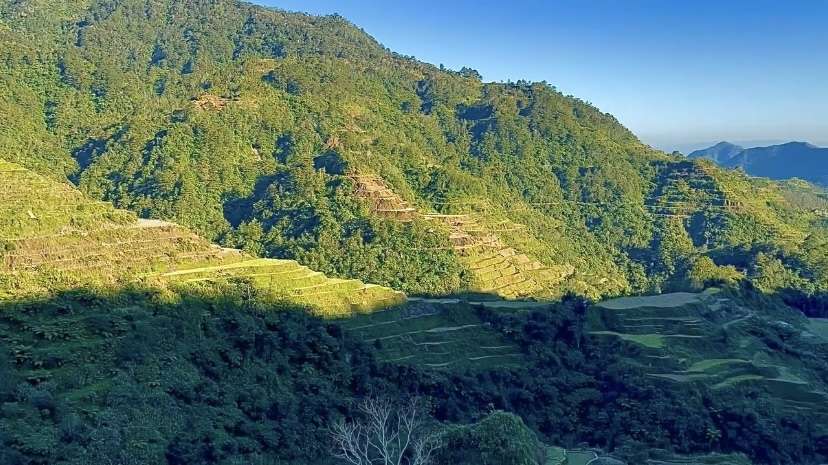Overview of Banaue Rice Terraces
The Banaue Rice Terraces are a remarkable landscape located in the mountains of north-central Luzon in the Philippines. This extensive array of terraces has been carefully carved by the Ifugao people, an indigenous group with a deep understanding of rice culture and sustainable agricultural practices.
The Ifugao’s very deep connection to the land is evident in these terraces, which they have maintained for over 2,000 years.
In 1995, UNESCO acknowledged parts of these terraces as a World Heritage Site. Some people unofficially call them the “Eighth Wonder of the World” because they show how people and nature work together well.
Exploring Bohol without checking out the famous Chocolate Hills would be like missing out on something really cool! When I got to Carmen, I was amazed to see lots of hills spread out everywhere.
And guess what? It only costs one hundred pesos (less than two dollars) for adults, fifty pesos (less than a dollar) for children, and it’s free for senior citizens and PWDs to get in and see them up close! That’s like pocket change for the awesome view you get from the top of one of those hills. Seriously, it’s like looking out at a sea of chocolate-colored bumps.
The best part? It’s super cheap, so anyone can enjoy it without worrying about spending too much money. Plus, you can have a blast taking funny pictures pretending to hold the hills in your hands! What are you waiting for? Pack and visit now!

Key Highlights:
- Location: North-central Luzon, Philippines
- Creators: Ifugao people
- Age: Over 2,000 years old
- Elevation: Approximately 1,500 meters above sea level
- UNESCO Status: Part of the Rice Terraces of the Philippine Cordilleras World Heritage Site
These fields boast an ancient irrigation system that channels water from the rainforests above the terraces. The system sustains the rice fields, displaying an early yet still effective method of water management.
The Banaue Rice Terraces stand as a living cultural landscape and are a testament to the Ifugao’s ingenuity in creating a sustainable and resource-efficient farming method that has stood the test of time.
It is in these lofty elevations that the Ifugao have planted rice – a staple food that has shaped their way of life, their customs, and their collective identity.
Table of Contents
History and Significance

The Banaue Rice Terraces are a testament to the innovative engineering and rich cultural heritage of the Ifugao people. Recognized as a National Cultural Treasure, these terraces have withstood the test of time, highlighting the Ifugao’s mastery over rice cultivation and irrigation.
Ifugao People and Culture
The Ifugao people, native to the mountainous regions of Luzon in the Philippines, have traditionally centered their culture around rice agriculture.
Their complex social systems and cosmology are deeply intertwined with the cultivation of rice, which is more than a staple food; it is a core aspect of their identity.
The careful preservation of rice variety known as tinawon, a traditional prestige variety, plays a crucial role in their rituals and traditions.
The craftsmanship of the Ifugao, utilizing intricate stonework and earthwork, reflects a deep understanding of their environment and the need to sustainably manage it.
Engineering Marvels of the Ancient Irrigation System
Engineered more than 2,000 years ago, the Banaue Rice Terraces exhibit an advanced understanding of irrigation systems and soil conservation techniques.
These methods have allowed the Ifugao to create and maintain terraces that maximize farmable land in mountainous terrain, preventing erosion and sustaining fertile soil.
Irrigation System: A complex network channels water from the rainforests above the terraces into a cascading irrigation system. This ensures that all terraces receive an adequate supply of water all year round.
- Terrace Structure: The terracing requires minimal intervention to maintain its structure, a combination of stonework supporting the terrace walls and the careful arrangement of earthwork allows for natural drainage and sedimentation to reinforce the terrace walls.
This ancient system reflects the Ifugao’s mastery over their environment, allowing them to thrive in a challenging landscape and creating a sustainable agricultural system that has endured for centuries .
Tourism and Activities

The Banaue Rice Terraces offer visitors a unique combination of cultural history and natural beauty. Tourism in this region focuses on the remarkable landscapes and the traditional practices associated with them, providing a range of activities for travelers interested in both adventure and cultural insights.
Batad and Mayoyao Rice Terraces
Batad Rice Terraces: Recognized as a UNESCO World Heritage site, the Batad Rice Terraces are often described as ‘amphitheater-shaped.’
Visitors typically spend 1-2 nights in this area to fully appreciate its splendor.
- Tappiyah Falls: While in Batad, tourists can hike to the nearby Tappiyah Falls, an impressive waterfall that’s a popular side trip.
- The hike to Tappiyah Falls is steep and can be challenging, but rewards hikers with scenic views.
Mayoyao Rice Terraces: Less frequented by tourists, the Mayoyao Rice Terraces offer a more secluded experience. These terraces showcase a unique stone-wall construction, different from the mud-wall terraces seen elsewhere.

Hiking and Sightseeing
Hiking Options: The region boasts numerous hiking trails that range in difficulty and duration.
- Short Hikes: For those seeking less strenuous activities, short walks around the villages allow for immersive cultural experiences and breathtaking views of the terraces.
- Longer Treks: More adventurous travelers, longer treks are available, such as the hike to Mt. Amuyao, which stands at 2,702 meters and provides panoramic vistas.
Sightseeing Locations:
- Banaue Viewpoint: Located just a few kilometers from the town center, this spot offers one of the best views of the Banaue Rice Terraces.
- Cultural Encounters: Beyond the terraces, visitors can explore the town of Banaue, which holds a wealth of Ifugao cultural artifacts and demonstrates traditional ways of life.
Environmental and Cultural Conservation

The Banaue Rice Terraces are not only a testament to ancient engineering prowess but also embody a millennia-old culture. Protecting this dual heritage includes both environmental conservation and the preservation of cultural practices, amid modern threats and the need for sustainable tourism.
Threats and Restoration Efforts
Threats: The terraces face environmental degradation from numerous fronts, including soil erosion, natural calamities, and unsustainable farming practices.
Additionally, the lure of urbanization has drawn younger generations away, leading to a shortage of traditional knowledge bearers for terrace maintenance.
Restoration Efforts: In response to these challenges, conservation strategies focus on restoration and sustainable practices.
Initiatives like reestablishing native rice varieties better suited for the terrain, and employing traditional irrigation methods are being bolstered.
Funds have been allocated, stretching beyond 2020, to reinforce physical structures and revitalize eco-friendly agricultural methods.

Community Involvement in Terrace Maintenance
Community Role: The Ifugao people’s intimate knowledge and generational skills are irreplaceable assets in maintaining the terraces.
Past management was overseen by national authorities, but a shift towards a community-based approach is deemed crucial for sustainability.
Maintenance Practices: It involves tapping into local expertise in terrace maintenance and soil conservation, ensuring that modern techniques harmonize with longstanding traditions.
Community members are stewards of both the land and culture, embedding sustainable tourism tenets that respect and sustain their way of life while opening it to the world in a responsible manner.
Agriculture and Festivities

The Banaue Rice Terraces exemplify a seamless blend of agriculture and cultural festivities. The Ifugao people observe a cyclical calendar rooted in the rhythms of planting and harvesting, punctuated with vibrant rites and feasts expressing gratitude for agricultural bounty.
Harvest Season and Agricultural Rites
Harvest season marks a time of both intense activity and social cohesion among the Ifugao.
Rice, the primary crop, is collected from the rice fields with care, following methods passed down over centuries.
During this period, agricultural rites are performed that are integral to the community’s beliefs.
These rituals call for blessings upon the crops and express thanks to ancestral spirits. Not limited to rice, vegetables grown on the terraces are also gathered, often timed with the rice harvest.
Festivals and Thanksgiving Feasts
Festivals and holy days are intertwined with the agricultural calendar.
The Ifugaos honor their deities and the earth through feasts and celebrations such as the Pahiyas and Imbayah.
Thanksgiving feasts are communal, with everyone partaking in the shared joy of a successful harvest.
These festivals are marked by an abundance of rice consumption, as the grain plays a quintessential role in Ifugao culture, symbolizing sustenance and life.
Travel Information

Travelers eager to experience the beauty of the Banaue Rice Terraces have various options for reaching this UNESCO World Heritage site. The journey often starts in Manila, the capital of the Philippines, situated on the island of Luzon.
From Manila
Buses travel daily from Manila to Banaue, with a journey taking approximately 8-10 hours.
The terminal in Manila is often located in Sampaloc. Visitors might prefer overnight buses, which are air-conditioned and made for comfort over the long journey through mountainous terrain.
Via Baguio
Alternatively, travelers may opt to take a bus to Baguio, a scenic city 6 hours from Manila, before continuing to Banaue. This multi-leg journey involves:
- Manila to Baguio: Approximately 6 hours.
- Baguio to Bontoc: Around 6 hours travel time.
- Bontoc to Banaue: Local buses run from Bontoc to Banaue, taking about 2 hours.
Buses from Baguio typically depart early in the morning, and from Bontoc, travelers can catch buses to Banaue as early as 7:00 a.m. From Banaue, visitors often make their way to Tam-an Village, close to the main viewpoint of the terraces.
Local Transportation
Upon arrival in Banaue, jeepneys, the Philippines’ traditional jeeps converted into public utility vehicles, allow travelers to journey between neighboring towns and villages, engaging themselves in the local culture and landscapes.
Jeepneys are an economical and authentic way to navigate the area.
Frequently Asked Questions
This section addresses some of the common queries about the Banaue Rice Terraces, providing clear and concise information for those interested in learning about this iconic site.

How can one get to the Banaue Rice Terraces?
Travelers can reach the Banaue Rice Terraces by bus from Manila, which takes about 9 hours, potentially longer with traffic.
An alternative is to fly to Baguio, then take a bus, though this does not significantly reduce travel time.
What is the history behind the Banaue Rice Terraces?
The Banaue Rice Terraces are estimated to have been constructed over 2,000 years ago by the indigenous people of Ifugao. They ingeniously carved the terraces into the mountainside to cultivate rice.
What makes the Banaue Rice Terraces a UNESCO World Heritage site?
Declared a UNESCO World Heritage site, the Banaue Rice Terraces represent a masterpiece of engineering and ancient agriculture, showcasing the harmony between people and nature, and an enduring cultural landscape.
What are some of the notable features of the Banaue Rice Terraces?
The terraces are a testament to the enduring Ifugao agricultural practices, built with minimal use of machinery, and dependent on a complex ancient irrigation system that draws water from the forests of the mountain tops.
How are the Banaue Rice Terraces maintained and preserved?
Local communities are directly involved in the repair and preservation of the terraces’ ancient stone walls and irrigation system.
This continuous care allows them to continue serving as functional farmland as well as a historical site.
What are the cultural significances of the Banaue Rice Terraces to the indigenous people?
For the Ifugao people, the terraces hold profound sociocultural significance. They are closely linked to their identity, religious ceremonies, and community cooperation, thus embodying their immense respect for the land and their ancestors’ heritage.
